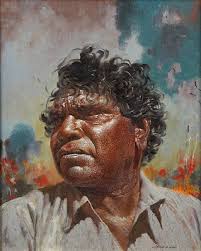It’s Australia Day weekend and there’s plenty to celebrate. Plenty to think about, too. My mind goes back to an outback trek that my good friend Steve Banks and I did with our respective families way back in 1999. One of many highlights was a stopover in Alice Springs, where I first heard the life story of Aboriginal artist Albert Namatjira and saw on the streets a level of disadvantage among indigenous people that I hadn’t previously witnessed. The experience made an impression that stayed with me long after I returned to Sydney and led to my writing a song, Shadows in a Landscape. You can hear a demo here, with Steve on vocals and guitar and yours truly on piano.
I think of it as exploring two kinds of alienation—that of black people from white, and white people from themselves (and each other).
Portrait of Namatjira by Alfred Herbert Cook
Namatjira (1902–1959) cuts a lonely figure in Australian history. He set himself apart from other Aboriginal artists by painting (brilliantly) landscapes in a European/Western style. He earned genuine appreciation among the white art cognoscenti of the day and popular acclaim—although one suspects that the latter was tinged with condescension and a feeling that Namatjira was proof that the black man could be “civilised” and assimilated. He became an Australian citizen.
Central Australian Landscape by Albert Namatjira
The fame and relative wealth he achieved brought the cultural ambiguities of his situation to a head. His status obliged him to look after his kinfolk and led to his supplying alcohol to members of his extended family. This was illegal, and Namatjira was jailed. He was a proud man and the experience profoundly affected him; he died a year or two after his release. More details here.
So that’s the black/white alienation story behind the song; the white/white alienation is (in my view) implied in the journey through the desert in the last verse, the driver leaving his normal life behind, finding some escape but no ultimate refuge in the landscape around him. One of my favourite memories from our trek is that of standing in the Simpson Desert, looking at the horizon and seeing the curvature of the earth. The sense of personal insignificance in all that vastness was oddly liberating.
Namatjira is no longer fashionable among the cognoscenti. The cultural shift from the White Australia policy that ended in 1973 to today’s multiculturalism means that our urban elites regard Namatjira as the symbol of a discredited era. They prefer traditional Aboriginal dot painting. This is an ironic reversal of the polarities of Namatjira’s situation, but is really no more than the same old black/white alienation in an updated form.
Happy Australia Day.


